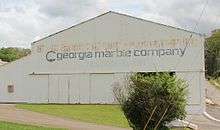Georgia Marble Company
The Georgia Marble Company was founded in 1884 by Samuel Tate. Tate leased out all the land in Pickens County, Georgia, United States, that contained rich Georgia marble. Pickens County has a vein of marble 5 to 7 miles (8.0 to 11.3 km) long, a half mile wide, and up to 2,000 feet (610 m) deep.[1]
Company history
.jpg)

In the 1830s Henry Fitzsimmons established the first marble quarry in Pickens County, which was part of the Murphy Marble Belt.[2] In 1884, Samuel Tate founded the Georgia Marble Company, and leased out the land for others to use. In 1905 Colonel Sam Tate partnered with Dawson Mathias Caldwell and the two became co-presidents and general managers of the company. The business grew rapidly, until concrete began to replace marble in buildings.[1] In 1969, with business falling, the company was purchased by Jim Walter Corporation.[2] Over the next few decades it changed hands several times, passing through ownership by Kohlberg Kravis Roberts and Company, Hillsborough Holding Corporation, First Chicago Corporation and IMERYS.[2] Finally, in 2003, the dimension stone division of Georgia Marble Company was acquired by Polycor.[3]
Flood
On January 7, 1946 the Etowah River in nearby Cherokee County reached a depth of 26.7 feet (8.1 m), and flooded the county including the Georgia Marble Company plant, which was covered with one foot of water.[4]
Notable commissions
- Bok Tower Gardens in Lake Wales, FL. Designed by architect Milton Bennett Medary, features sculpture by Lee Lawrie.
- New York Stock Exchange annex as well as the pediment in it created by John Quincy Adams Ward and carved by the Piccirilli Brothers[5],
- Daniel Chester French's Abraham Lincoln statue in the Lincoln Memorial in Washington, D.C., carved by the Piccirill Brothers,[6]
- National Air and Space Museum
- East Wing of the National Gallery of Art
- Federal Reserve Bank of Cleveland and Integrity and Security allegorical figures by Henry Hering, carved by the Piccirilli Brothers Cleveland, Ohio ca. 1923
- Civic Virtue Triumphant Over Unrighteousness sculpture group and fountain created by sculptor Frederick William MacMonnies and architect Thomas Hastings, and carved by the Piccirilli Brothers.(1922) [7]
- Buckingham Fountain in Chicago.[1] (1927)
- National McKinley Birthplace Memorial, McKim, Mead and White architects and J. Massey Rhind’s statue of William McKinley, in Niles, Ohio, (1915) [8]
Marble
The company's mines contain some of the best quality marble, and almost every type of marble found in the USA. The marble, when exposed to the weather tends to become less durable from acid rain. The mine is plentiful and every variety with every size is extractable with machinery,[9] and transported by railroad.[2] Types of marble include crystallized marble, and white sanctuary marble ranging in a variety of colors.[9]
References
- 1997 Marble Valley Historical Society (September 30, 2009). "A short history..." GAGenWeb Project. Archived from the original on August 5, 2002. Retrieved 2009-09-30.
- "Introduction to Historic Georgia Marble Movies". Georgia Digital Library. Retrieved 2009-10-01.
- Stone Business. 2009-10-06 http://www.stonebusiness.us/index.php?option=com_content&view=article&id=871&Itemid=2. Retrieved 2009-09-30. Missing or empty
|title=(help) - Fuller, Ashley (September 26, 2009). "A record, remembered". Cherokee Tribune. Retrieved 2009-09-30.
- Daneker, Jerome G., "The Romance of Georgia Marble, Thomsen-Ellis Company, Baltimore, 1927 p. 66
- Daneker 1927, p. 65.
- Daneker 1927, p. 75.
- Daneker 1927, pp. 46-47.
- "Quarrying: The Carrara Quarries". The Manufacturer and Builder. 0016 (12): 278–9. December 1884. Retrieved 2009-09-30.